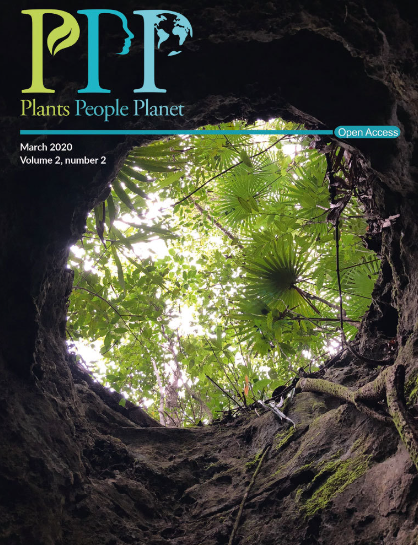从高粱加入板中提取的独脚金内酯生物合成lgs1突变等位基因是抗独脚金寄生的一个有前景的资源
IF 3.6
2区 环境科学与生态学
Q1 BIODIVERSITY CONSERVATION
引用次数: 0
摘要
Striga是一种寄生植物,它极大地限制了非洲最主要谷物的生产,包括高粱。当寄生虫对从宿主根部释放到土壤中的生物分子作出反应而发芽时,就会发生感染。一些高粱基因型含有一种突变,使它们无法刺激斯特里加菌种子发芽。这种抗性非常重要,因为它可能应用于斯特里加的管理。本文讨论了具有不同程度斯特riga抗性的其他抗性高粱基因型在育种计划中的候选资格,以及它们通过减少斯特riga侵袭造成的作物损失,在缓解撒哈拉以南非洲粮食不安全方面可能发挥的作用。高粱是撒哈拉以南非洲数百万人的主食,但它的产量被一种寄生杂草Striga大大减少。在非洲的小农农场中管理斯特里加菌的一种有效且具有成本效益的方法是部署具有抗性的高粱品种。在这里,我们利用基因组学和高粱的巨大遗传多样性——进化适应了非洲的斯特riga寄生——通过利用一种依赖于被称为斯特riga内酯(SLs)的通讯分子的抗性机制,鉴定出新的抗斯特riga高粱基因型,这种分子由宿主分泌,以触发寄生虫种子萌发。我们通过挖掘低萌发刺激物1 (LGS1)的突变等位基因来实现这一目标,这些突变等位基因对高粱接穗板(SAP)的Striga萌发无效。我们的分析鉴定出lgs1高粱基因型,我们将其命名为SAP‐lgs1。SAP‐lgs1具有已知lgs1高粱的SL分泌物特征,其标志是产生低萌发诱导剂,orobancho。实验室和田间抗性筛选显示,SAP‐lgs1基因型对斯特里加病毒也表现出显著的抗性。我们的发现有可能减少因斯特里加线虫寄生造成的作物损失,因此对改善非洲的粮食安全具有深远的意义。本文章由计算机程序翻译,如有差异,请以英文原文为准。
Strigolactone biosynthesis lgs1 mutant alleles mined from the sorghum accession panel are a promising resource of resistance to witchweed (Striga) parasitism
Societal Impact Statement Striga is a parasitic plant that greatly limits the production of Africa's most staple cereals, including sorghum. Infection occurs when the parasite germinates in response to biomolecules emitted into the soil from the host's roots. Some sorghum genotypes harbor a mutation that makes them ineffective in stimulating Striga seed germination. This resistance is of great importance because of its possible application in Striga management. Here, additional resistant sorghum genotypes with varying levels of Striga resistance are discussed in the context of their candidacy for integration in breeding programs and their possible role in alleviating food insecurity in sub‐Saharan Africa by reducing crop losses because of Striga infestation. Summary Sorghum is a food staple for millions of people in sub‐Saharan Africa, but its production is greatly diminished by Striga , a parasitic weed. An efficient and cost‐effective way of managing Striga in smallholder farms in Africa is to deploy resistant varieties of sorghum. Here, we leverage genomics and the vast genetic diversity of sorghum—evolutionarily adapted to cope with Striga parasitism in Africa—to identify new Striga ‐resistant sorghum genotypes by exploiting a resistance mechanism hinged on communication molecules called strigolactones (SLs), exuded by hosts to trigger parasite seed germination. We achieved this by mining for mutant alleles of the LOW GERMINATION STIMULANT 1 ( LGS1 ) that are ineffective in stimulating Striga germination from the sorghum accession panel (SAP). Our analysis identified lgs1 sorghum genotypes, which we named SAP‐ lgs1 . SAP‐ lgs1 had the SL exudation profile of known lgs1 sorghum, whose hallmark is the production of the low inducer of germination, orobanchol. Laboratory and field resistance screens showed that the SAP‐ lgs1 genotypes also exhibited remarkable resistance against Striga . Our findings have the potential to reduce crop losses because of Striga parasitism and therefore have far‐reaching implications for improving food security in Africa.
求助全文
通过发布文献求助,成功后即可免费获取论文全文。
去求助
来源期刊

Plants People Planet
Multiple-
CiteScore
9.90
自引率
5.90%
发文量
81
审稿时长
12 weeks
期刊介绍:
Plants, People, Planet aims to publish outstanding research across the plant sciences, placing it firmly within the context of its wider relevance to people, society and the planet. We encourage scientists to consider carefully the potential impact of their research on people’s daily lives, on society, and on the world in which we live. We welcome submissions from all areas of plant sciences, from ecosystem studies to molecular genetics, and particularly encourage interdisciplinary studies, for instance within the social and medical sciences and chemistry and engineering.
 求助内容:
求助内容: 应助结果提醒方式:
应助结果提醒方式:


